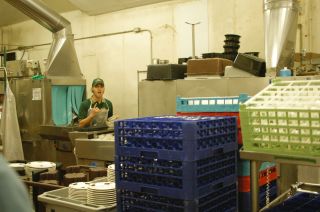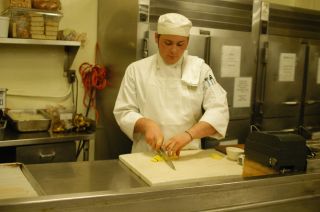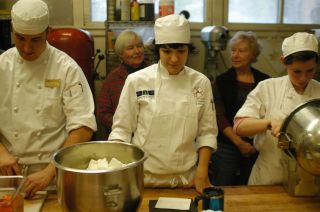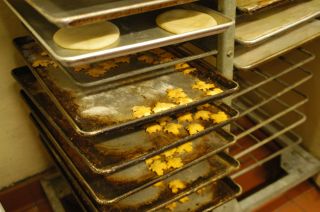
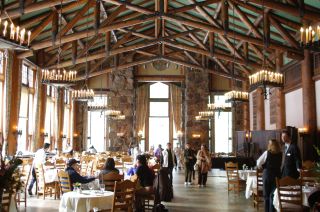 The Ahwahnee Hotel was completed in 1927 (to the tune of $1.5 million) to provide accommodations in Yosemite National Park fitting for visiting dignitaries who didn't want to "rough it". The Ahwahnee was not the first hotel constructed in Yosemite with this in mind, but it was the first designed to last. It is almost completely constructed of stone, concrete, and steel so that it would not meet the same doom as previous hotels in Yosemite - fire. The exterior facade of the Ahwahnee is constructed of poured concrete shaped and stained to resemble redwood. The only large wood construction in the hotel is the dining room which comfortably sits over three hundred.
The Ahwahnee Hotel was completed in 1927 (to the tune of $1.5 million) to provide accommodations in Yosemite National Park fitting for visiting dignitaries who didn't want to "rough it". The Ahwahnee was not the first hotel constructed in Yosemite with this in mind, but it was the first designed to last. It is almost completely constructed of stone, concrete, and steel so that it would not meet the same doom as previous hotels in Yosemite - fire. The exterior facade of the Ahwahnee is constructed of poured concrete shaped and stained to resemble redwood. The only large wood construction in the hotel is the dining room which comfortably sits over three hundred.If you're wondering about the name: The Ahwahnee name comes from the language of the Miwok Indians who lived in Yosemite Valley. They called the Valley "Ahwahnee" which many people agree means "Gaping Mouth" (although there is some disagreement about this). The Miwoks residing in Yosemite called themselves the Ahwahneechee while Miwoks residing in the Mariposa region to the south referred to them as the "Yehemite" meaning "some among them are killers". This word was most likely corrupted into the English name "Yosemite".
Throughout the month of January, the Ahwahnee Hotel features talks and demonstrations from guest chefs. The demonstrations are free on a first come, first serve basis while dining at the Gala dinner is $140 per person. Lucky for me, Tina and I happened to be vacationing in Yosemite. We decided to attend a demonstration by Josh Silvers (owner and chef of Syrah Bistro in Sonoma County, California) entitled "Romantic Dinner for Two" highlighting a New York steak, Clam Chowder, and Raspberry Chocolate Torte. Josh kept the room entertained and engaged throughout his demonstration and provided everyone a taste of the dessert.
 The next day, we toured the Ahwahnee Hotel kitchen with one of the sous chefs as our guide. It was explained to us that, just recently, the Ahwahnee kitchen had it's ventilation system upgraded. Prior to the $1.5 million (yep, the upgrade cost as much as the hotel's original price tag, ignoring inflation of course) upgrade, the kitchen temperatures would fluctuate from over 100&176;F (38&176;C) in the summer to below freezing in the winter. Now the kitchens are kept at an even 65 to 70°F. In the photograph below you can see the extremely high ceilings of the kitchen. The original architectural design intended for the hot air to have enough room to rise above the busy kitchen. The windows at the top were the only ventilation, allowing hot air to escape and cold air to be let in. Now that air conditioning has been installed, the temperature is no longer a problem, but it does create a great deal of noise.
The next day, we toured the Ahwahnee Hotel kitchen with one of the sous chefs as our guide. It was explained to us that, just recently, the Ahwahnee kitchen had it's ventilation system upgraded. Prior to the $1.5 million (yep, the upgrade cost as much as the hotel's original price tag, ignoring inflation of course) upgrade, the kitchen temperatures would fluctuate from over 100&176;F (38&176;C) in the summer to below freezing in the winter. Now the kitchens are kept at an even 65 to 70°F. In the photograph below you can see the extremely high ceilings of the kitchen. The original architectural design intended for the hot air to have enough room to rise above the busy kitchen. The windows at the top were the only ventilation, allowing hot air to escape and cold air to be let in. Now that air conditioning has been installed, the temperature is no longer a problem, but it does create a great deal of noise. One man handles all the room service at the Ahwahnee, whose 123 rooms aren't all inside the main building but include cottages as well. Later, when we saw this man rushing outside with a tray, we knew someone had called room service for lunch in one of the cottages.
One man handles all the room service at the Ahwahnee, whose 123 rooms aren't all inside the main building but include cottages as well. Later, when we saw this man rushing outside with a tray, we knew someone had called room service for lunch in one of the cottages.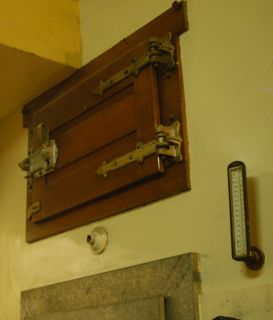 The refrigeration room held several refrigerator chambers side by side (I counted four from where I stood, but was told there were more). The chambers were designed to allow air circulation between each one to promote even cooling. Prior to the availability of condenser units, at the beginning of each winter, the hotel staff would go out to Mirror Lake (about 1.5 miles away) and cut 500 pound (225 kg) blocks of ice from the frozen lake. These blocks would be hauled back to the hotel and stored under straw and sawdust. When the refrigerators needed "refilling", the blocks were lifted by a winch and slid into these doorways situated above each chamber. Each of these doorways led to compartments big enough for ten 500-pound blocks of ice.
The refrigeration room held several refrigerator chambers side by side (I counted four from where I stood, but was told there were more). The chambers were designed to allow air circulation between each one to promote even cooling. Prior to the availability of condenser units, at the beginning of each winter, the hotel staff would go out to Mirror Lake (about 1.5 miles away) and cut 500 pound (225 kg) blocks of ice from the frozen lake. These blocks would be hauled back to the hotel and stored under straw and sawdust. When the refrigerators needed "refilling", the blocks were lifted by a winch and slid into these doorways situated above each chamber. Each of these doorways led to compartments big enough for ten 500-pound blocks of ice.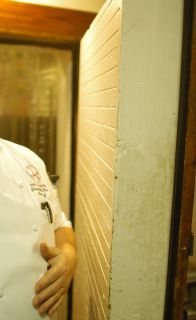 The ice is no longer used and condensers take their place, but one of the original refrigerator doors is still in use. (The others have been replaced with modern insulated doors.) This door is most likely filled with sawdust for insulation and in the photo below, it's easy to see just how thick the door is.
The ice is no longer used and condensers take their place, but one of the original refrigerator doors is still in use. (The others have been replaced with modern insulated doors.) This door is most likely filled with sawdust for insulation and in the photo below, it's easy to see just how thick the door is. All the bread in the hotel is prepared in the only remaining original oven. The oven, getting close to eighty years old, is (according to the head baker) the most accurate and precise oven in the facility and beats all the new convection and conventional ovens. However, a sign hanging on the oven asks politely that you "Never Turn Off This Oven". The baker says it takes anywhere from four to six hours for the oven to heat up, so they don't turn it off. When asked if the heating elements will ever wear out through the constant use, the baker responded after a pause: "I don't think they'll wear out."
All the bread in the hotel is prepared in the only remaining original oven. The oven, getting close to eighty years old, is (according to the head baker) the most accurate and precise oven in the facility and beats all the new convection and conventional ovens. However, a sign hanging on the oven asks politely that you "Never Turn Off This Oven". The baker says it takes anywhere from four to six hours for the oven to heat up, so they don't turn it off. When asked if the heating elements will ever wear out through the constant use, the baker responded after a pause: "I don't think they'll wear out."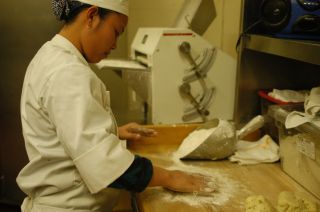 The pastry chef at the Ahwahnee is excellent, but she often finds that many people want to bring in their own cakes for weddings (which the Ahwahnee hosts about 300 per year). More often than not, these wedding cakes have fallen over or been crushed while been brought up to Yosemite over winding and bumpy roads. Sometimes, the cakes can be fixed, but other times the pastry department goes into overdrive to create a brand new cake. Should have ordered the cake from the Ahwahnee in the first place... Below, an assistant prepares pastry dough for the evenings countless pies.
The pastry chef at the Ahwahnee is excellent, but she often finds that many people want to bring in their own cakes for weddings (which the Ahwahnee hosts about 300 per year). More often than not, these wedding cakes have fallen over or been crushed while been brought up to Yosemite over winding and bumpy roads. Sometimes, the cakes can be fixed, but other times the pastry department goes into overdrive to create a brand new cake. Should have ordered the cake from the Ahwahnee in the first place... Below, an assistant prepares pastry dough for the evenings countless pies. That afternoon, the kitchen was in full swing preparing for the evening's special dinner. The following series of photographs show what little I was able to capture during my tour:
That afternoon, the kitchen was in full swing preparing for the evening's special dinner. The following series of photographs show what little I was able to capture during my tour: